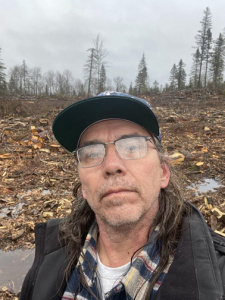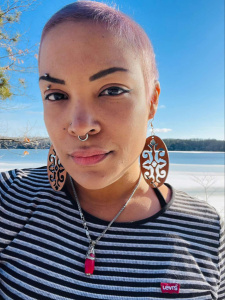
WEATHER WARNING!! The reception has been cancelled due to unsafe travel conditions. We will announce if the reception can be rescheduled.

Mayaadaaboonojig – “The Ones Drifting Off on the Current”
Zac Earley (Lead), Arden Ramay, & youth of Oshki Manidoo (Bemidji)
EXHIBIT December 5 , 2024 – February 8, 2025
RECEPTION The reception will be rescheduled for Zac Earley and Arden Ramay. Earley will speak about the exhibit and then he will follow with Ojibwe storytelling or Aadizookewin, the act of telling a sacred story
“This canoe is alive and has a spirit. Canoe building is not just building a canoe. It is bringing life into the world and honoring the gifts that the trees give us for life.
“There were many hands in building this canoe. Arden and I spent many hours in what we called Canoe purgatory lol. Also, the youth from Oshki had a hand and splitting roots and sewing bark. This canoe came from a dream that our language and culture would come back strong, and we could honor the spirits in the water and in the forest. Our ancestors have been making birch bark canoes for at least 20,000 years without ever depleting the birch. We are going to continue building canoes here on earth, as long as the forest still provides.” – Zac Early
Exhibit Highlights – click any image to enter slide show.
Curator’s Statement
Hosting this canoe build has provided a way for Miikanan Gallery, as a part of Watermark Art Center, to move forward with exploring community wellness through arts. We partnered with Oshki Manidoo, a White Earth operated recovery center, located in Bemidji.
Oshki Manidoo provided space where youth and staff were able to watch and participate in various aspects of assembling the canoe.
Zac Earley, a gifted artist and Ojibwe culture keeper was the lead for the project. His experience with community canoe builds and his work as a traditions keeper made him a good candidate to bring into the wellness space. (Additional pieces created by Earley will be on display, as well.)
Early brought in Arden Ramay to assist with the build. Her extraordinary talent as an artist meshed well with Zac’s. Their energy and heart given to the project resulted in an exceptionally beautiful canoe that honors the stories of the Ojibwe people.
This is a first time for Miikanan to host a project of this kind. It provided both challenges and an excitement as it unfolded.
The title of this exhibit perfectly encompasses the journey taken for this meaningful accomplishment. We are truly grateful to the people at Oshki Manidoo that supported and contributed to the project. We are looking forward to the canoe river/lake launch next spring and are happy knowing that it has a home at Oshki Manidoo.
The canoe will continue to provide meaningful experiences and tell stories in ways that will contribute to the recovery and wellness of individuals for years to come. – Karen Goulet, Program Director Miikanan Gallery
Artist Statement – Zac Earley:
 Binesi dagoshin aka Zachariah mitteness a.k.a. Zach Earley.
Binesi dagoshin aka Zachariah mitteness a.k.a. Zach Earley.
I’ve always had a fascination with boats and canoes since I was a little kid. I am proud of my Anishinaabe heritage. My dad Raymond Earley was an enrolled member of White earth. He was one of my biggest inspirations in my life and encouraged me to endeavor to learn our language and traditional ways of life in our Ojibwe customs. I was Given an Ojibwe name and clan. When I was given my name, I was also given dizhiwinag (sacred items). One of those items was a birchbark basket. It was given to me by my great aunt, the deceased Beatrice Swanson/Laqueirre, from White Earth.
I lived in the city at the time I was enamored by Birch bark. Then later on when I would visit my we’ehyag In Fond du Lac (Sawyer). I was taught how to gather birchbark and make nooshkaachinaaganan (winnowing baskets). These baskets were used to fan wild rice in the finishing process. My weh’ehyag Jim and Pat Northrup were excellent basket makers and made birch bark baskets every summer. When I started I often visited and would stay at my We’ehyags home. This is when I became immersed In our culture and more interested in learning my Ojibwe language. While in Fond Du Lac, I met a canoe builder named Marvin Defoe from Redcliff. Even though I did not participate much in his canoe building, I witnessed some of it and was inspired.
Years later, I became friends with Kevin Finney from Michigan. Also, FRANK SPRAGUE and Laban Smith who were a team of Canoe builders. They came to Ponemah and built two canoes. I was a part of the canoe builds. I was living in Bemidji, Minnesota. I also met Nate Johnson, who is an excellent seasoned Canoe builder, and has given me tips in Canoe building.
When I build canoes, I feel connected to my ancestors, and I feel connected to the land. The forest and the trees I realize the interconnectedness of everything building is a lot of work. It is very difficult to find quality birchbark suitable for a canoe, especially nowadays with all of the logging clear cuts Land, privatization, and global climate change.
When I search for bark I see how our forests are suffering and are being ravaged for money and profit. It is very sad and oftentimes I feel angry and depressed. We need big trees, healthy trees to continue birch bark canoe building. We need big trees and healthy forests for our traditional ways of life and life in general we all need to breathe.
Artist Statement – Arden Ramay
 I’m Arden, an artist based in Lac Courte Orellies.
I’m Arden, an artist based in Lac Courte Orellies.
My work primarily revolves around acrylic paint and sewing appliqué, both mediums allow me to blend vibrant colors and play with textures.
As a proud member of the Ojibwe community, my art is heavily influenced by my heritage and cultural background. I started creating when I was very young making regalia and sketching designs. I remember being in grade school and being obsessed with drawing powwow dancers. My mother taught me how to bead and sew, this is how I discovered my love for drawing florals and using bold colors with appliqué. Whether it’s through abstract landscapes or traditional symbols, I strive to capture the beauty and resilience of the Ojibwe people.
As I refined my floral style I began painting on leather and then moved on to canvas which is my now favorite. I still enjoy creating art representing my identity as a native person but in recent years I find myself creating work that may not come off straight away as “ojibwe” or “native” . This gives me the opportunity to say “this IS Native art because I’M creating it.” merging traditional and abstract design I would like to think it’s a way to contribute to the art world more than what is expected from a Native artist.
This activity was made possible by the voters of Minnesota through a grant from the Minnesota State Arts Board, thanks to a legislative appropriation from the arts and cultural heritage fund.
Watermark Art Center would like to thank the following organizations for supporting our summer birch bark canoe build: Oshki Manidoo Center, White Earth Nation Behavioral Health and Language and Culture Program.




